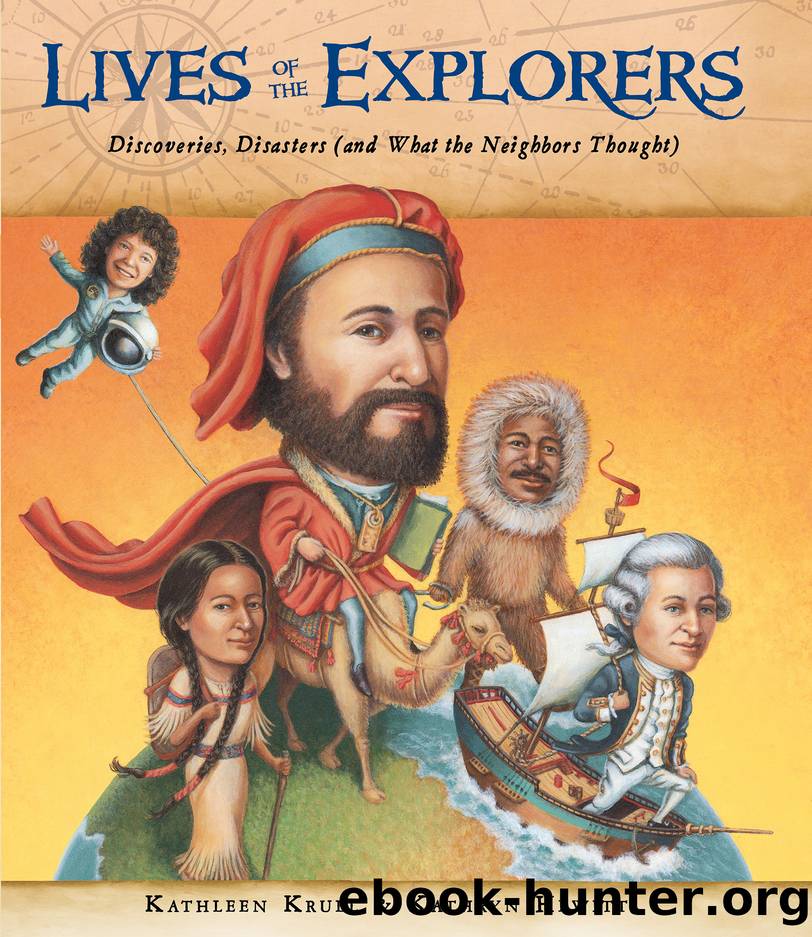Lives of the Explorers by Kathleen Krull

Author:Kathleen Krull
Language: eng
Format: epub
Publisher: Houghton Mifflin Harcourt
BORN IN IDAHO OR MONTANA, 1788(?); DIED IN FORT MANUEL, NORTH DAKOTA, 1812 (SACAJAWEA)
Two American explorers and their Shoshone Indian interpreter on an epic journey
Meriwether Lewis and William Clark had much in common. Both were well-to-do Virginia planters, slaveholders, and army veterans. They were four years apart in age and got along well. So when President Thomas Jefferson asked Captain Lewis to explore the giant parcel of land known as the Louisiana Purchase, Lewis chose Clark to be his co-captain. They were to set out from St. Louis, Missouri, leaving the known United States behind, heading west with the nearly impossible goal of crossing the Rocky Mountains and reaching the Pacific Ocean.
Sacajawea had virtually nothing in common with either Lewis or Clark. But they could not have made their journey without her.
Lewis had grown up fast, taking care of his family and managing his plantation at a young age. He was a skilled hunter and well-educated, keenly interested in natural history and medicinal herbs. At least one of his neighbors admired him—President Jefferson, who praised his “luminous and discriminating intellect” and hired him as his secretary. Lewis mixed with big names in politics and the arts, polished his manners, and learned to dance.
But, despite actively trying, he never married. “His person was stiff and without grace,” said a cousin, “bow-legged, awkward, formal, and almost without flexibility.” Another man called him “an overgrown baby.” Some historians think Lewis suffered bouts of depression. Even James Madison’s bubbly wife, Dolley, couldn’t match him up. Lewis started referring to himself as “a musty, fusty, rusty, old bachelor.”
Redheaded Clark was more amiable and less moody than Lewis. He had little formal education—he spelled “Sioux” twenty-seven different ways—but was a big reader of geography and history as well as novels. After his journey with Lewis, he married twice, had eight children, and was a founding member of his local Episcopal church. But he treated slaves cruelly, and bragged that they remained with him even after they’d been offered freedom.
To prepare for their journey west, Lewis and Clark added thirty-eight members to their group, called the Corps of Discovery. The men had to be “stout” (healthier than the average American), good hunters or able to offer another necessary skill, unmarried, and able to withstand harsh conditions over two years. The youngest was seventeen; the oldest, thirty-five. All were white except Clark’s slave, York. Lewis’s Newfoundland dog, Seaman, went along. Their provisions included a vast assortment of gifts for the Indians they would encounter, 120 gallons of alcohol, and a great deal of medicine. (With 600 mercury capsules used as laxatives, it is said the Corps’s path can still be traced by way of mercury deposits in the soil.)
The day of departure in 1804 was among the happiest of Lewis’s life. In his journal he dared to compare himself to Columbus and Cook, and said, “We were now about to penetrate a country at least two thousand miles in width, on which the foot of civilized man had never trodden; the good or evil it had in store for us was for experiment yet to determine.
Download
This site does not store any files on its server. We only index and link to content provided by other sites. Please contact the content providers to delete copyright contents if any and email us, we'll remove relevant links or contents immediately.
Pale Blue Dot by Carl Sagan(4001)
Bloody Times by James L. Swanson(3980)
I'm Still Scared by Tomie dePaola(3912)
Pocahontas by Joseph Bruchac(3722)
Little Author in the Big Woods by Yona Zeldis McDonough(3124)
Seriously... I'm Kidding by Ellen DeGeneres(3100)
Earthrise by Edgar Mitchell(2757)
The Science Book (Big Ideas Simply Explained) by DK(2745)
The President Has Been Shot!": The Assassination of John F. Kennedy by Swanson James L(2732)
Hello, America by Livia Bitton-Jackson(2721)
The Extraordinary Suzy Wright by Teri Kanefield(2344)
Ben Franklin's Almanac by Candace Fleming(2054)
Brown Girl Dreaming by Jacqueline Woodson(2016)
Cleopatra: A Life by Stacy Schiff(1933)
Birds, Beasts and Relatives by Gerald Durrell(1861)
The Audition by Maddie Ziegler(1814)
I Will Always Write Back by Martin Ganda(1765)
Bloody Times: The Funeral of Abraham Lincoln and the Manhunt for Jefferson Davis by James L. Swanson(1723)
The Complete Adventures of Curious George by H. A. Rey(1690)
